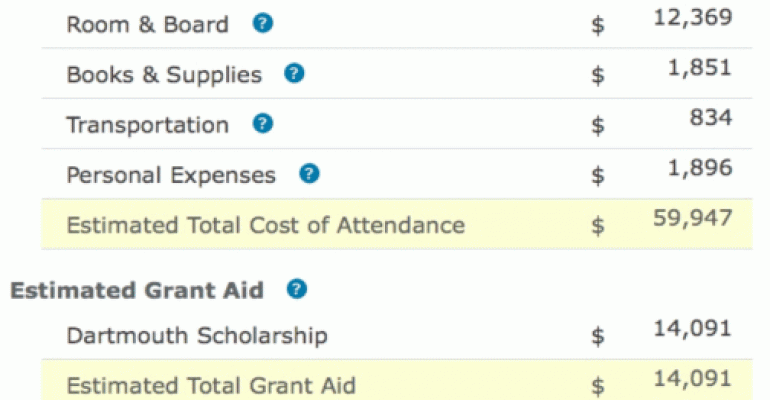How much will college cost us?
That's the question all parents want to know, but traditionally they have been left in the dark until each spring when the acceptance letters and aid awards arrive in the mail. When students receive awards that are skimpy—or none at all -- they are in trouble since it is too late to apply elsewhere.
There is no reason, however, why your clients need to tolerate those unpleasant spring surprises. Thanks to a new federally mandated cost calculator, parents can learn far in advance what a particular college will cost them, which should lead to better informed decisions.
These so-called net price calculators can provide your clients with a personalized estimate of what the cost of a particular college will be. The net price is what a family would be expected to pay after grants and scholarships are subtracted.
Calculators will vary by schools, but they should typically take no more than a few minutes to complete. To get an accurate estimate, parents will need to pull figures off their most recent tax return, as well as statements for college savings and taxable accounts.
Dartmouth College's Cost Calculator
To show you how they work, I tried out Dartmouth College's net price calculator using a hypothetical couple, who has one child heading to college and another attending high school. Here are the main figures that I plugged into the calculator:
· Parents' combined income: $150,000
· Home equity: $225,000
· Cash/checking: $25,000
· Non-retirement investments: $75,000
· Standardized federal tax deductions: $20,000
· Teenager's earnings: $2,000
· Parents’ contributions to 401(k): $10,000
As you can see below, the Dartmouth calculator estimated that the parents would receive $14,091 in need-based financial aid. I’d suggest that most people with similar incomes and home equity would be surprised that they could qualify for need-based financial aid.

Experimenting with Cost Calculators
I recommend experimenting with the calculators to see how schools award different amounts of money based on the questions asked, as well as an institution's level of generosity. The University of Chicago's calculator, for instance, doesn't ask about the expenses of private schooling for younger children or medical expenses not covered by insurance, but Dartmouth's does.
Amherst College’s Cost Calculator
I experimented with a slightly different scenario when I used Amherst College’s net price calculator. I plugged in the same figures that I used for Dartmouth except this time the hypothetical family didn't own a house. Without home equity, the need-based aid for the family doubled to $28,350.

Bottom Line:
Now is the time to tell your clients about these cost calculators, which must be installed on college websites no later than Oct. 29. Cost calculators will empower families by allowing them to know the true cost of individual colleges long before their teenagers begin applying.
I predict your clients will be thrilled when you share this news with them.
Story No. 2:
Graduate in 4 Years
One of the best ways to cut the cost of college is to graduate in four years. Okay, that sounds obvious, but most students fail to pull this off.
Nationally, only 58% of full-time students manage to earn a bachelor’s degree in six years. The numbers are even grimmer for part-time students. Three out of four part-timers fail to earn a bachelor's degree within eight years.
You will rarely see schools publicize graduation rates, but it's easy to find four, five and six-year rates. Just head to College Results Online (www.collegeresults.org), which can provide you with the stats for any school.
Below you'll find the highest grad rates for research universities and colleges. As you'll see, the schools with the best grad rates all happen to be private institutions.
The public universities with the highest four-year grad rates are the University of Virginia (84.4%), College of William and Mary (83.2%) and the University of Michigan (72.7%).
Best 4-Year Grad Rates Among Research Universities
Yale University (CT) 90.4%
University of Notre Dame (IN) 90.1%
Princeton University (NJ) 89.9%
Duke University (NC) 88.5%
Harvard University (MA) 87.8%
Georgetown University (DC) 87.8%
University of Pennsylvania 87.6%
Northwestern University (IL) 87.3%
University of Chicago (IL) 85.7%
Brown University (RI) 85.6%
Cornell University (NY) 85.3%
Columbia University (NY) 85.0%
Tufts University (MA) 84.9%
Wake Forest University (NC) 84.8%
Emory University (GA) 84.8%
Best 4-Year Grad Rates Among Colleges
Williams College (MA) 93.2%
Carleton College (MN) 89.1%
Davidson College (NC) 89.0%
Pomona College (CA) 88.9%
Bowdoin College (ME) 88.8%
Wesleyan University (CT) 88.5%
US Naval Academy (MD) 88.2%
Haverford College (PA) 87.9%
Washington and Lee University (VA) 87.8%
Vassar College (NY) 87.8%
Bucknell University (PA) 87.6%
College of the Holy Cross (MA) 87.0%
Claremont McKenna College (CA) 86.3%
Lafayette College (PA) 86.0%
Bates College (ME) 86.0%
Story No. 3:
Show Me the Money
Families often look in the wrong places for college cash.
Many parents and teenagers assume that private scholarships are the largest source of college cash. As you can see from the chart, however, private scholarships represent the smallest source of free college money.

Writer's Bio: Lynn O'Shaughnessy is a college consultant, author and speaker. She writes three college blogs for CBSMoneyWatch, U.S. News & World Report and TheCollegeSolutionBlog.com.






